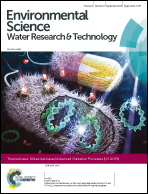Improving UV/H2O2 performance following tertiary treatment of municipal wastewater†
Abstract
The ability of UV/AOP to treat trace organic contaminants (TOrCs) in wastewater is inhibited by (1) UV light-absorbing species and (2) hydroxyl radical (˙OH) scavenging species. We address these challenges by investigating four diverse technologies, single-stage biofiltration, sequential biofiltration, coagulation–flocculation–sedimentation–filtration (CFSF), and nanofiltration, as options for improving water quality conditions just prior to UV treatment, with and without added hydrogen peroxide (H2O2). By evaluating UV254 transmittance (UVT), ˙OH scavengers, and ˙OH steady-state concentrations, we found nanofiltration treatment to produce the most favorable pre-UV and UV/H2O2 water quality conditions. In comparing CFSF, single-stage biofiltration and sequential biofiltration treatment, CFSF treatment resulted in the highest increase in UVT and all three technologies reduced the scavenging capacity by ∼24% despite differences in removal of typical ˙OH scavengers. UV and UV/H2O2 performance were evaluated by tracking the degradation rates of 11 targeted TOrCs for each pre-UV/H2O2 treatment scenario. Applying the additional treatment, average pseudo first-order degradation rates of TOrCs under UV/H2O2 increased by 20 to 92%, informing potential strategies to increase the oxidation potential of UV/AOP systems applied to wastewater.

- This article is part of the themed collection: Ultraviolet-based Advanced Oxidation Processes (UV AOPs)


 Please wait while we load your content...
Please wait while we load your content...